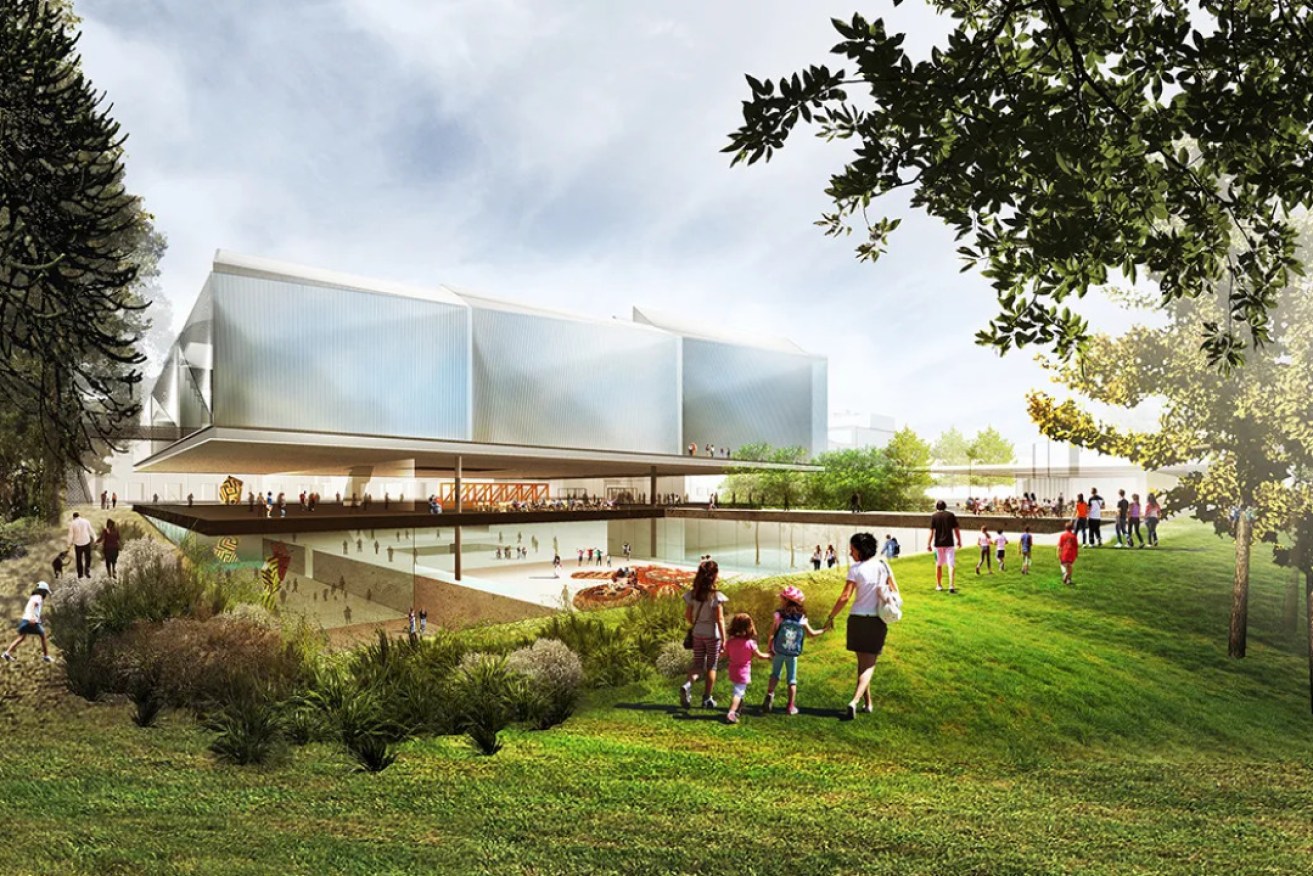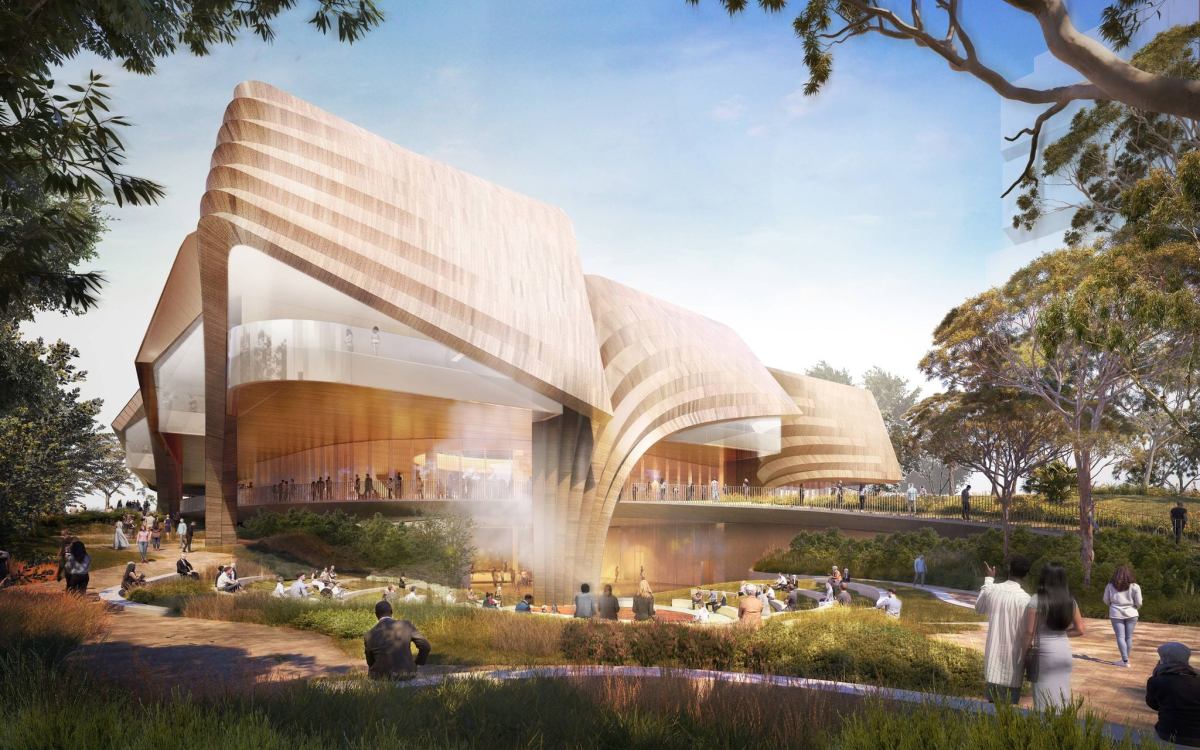Why Adelaide needs a new gallery for 21st century art
South Australia needs to switch directions on arts infrastructure to build a new contemporary art gallery on a key North Terrace site, argues curator and cultural historian Margot Osborne.

The winning design for an Adelaide Contemporary art gallery in 2018. The process was ended by the Marshall Liberal Government. Design by Diller Scofidio + Renfro and Woods Bagot, who would also later provide the concept design for the Aboriginal cultural centre proposed for Lot Fourteen.
The Art Gallery of South Australia is South Australia’s flagship for the visual arts.
Its exhibitions and its collections are critically acclaimed. It is a huge cultural attraction, providing free cultural experiences for both visitors and the Adelaide public across all generations.
Any cultural policy with respect to the visual arts should start with the importance of AGSA as the benchmark for cultural excellence both in terms of the practice of living artists and art of the past. But not only is it seriously underfunded to deliver on this by the state government, it also faces the need to prioritise the balance of temporary and permanent collection exhibitions across its numerous curatorial departments within the limitations of a comparatively small footprint.
AGSA simply can’t deliver on its wider potential within its current funding and space restrictions.
With the benefit of hindsight, it is now apparent that the decision by the former Liberal Government to abandon AGSA’s well-researched and well-conceived Adelaide Contemporary proposal in favour of an outline proposal for an Indigenous cultural centre, now called Tarrkarri, was a costly mistake.
In the interim since the Liberal Government took this hasty action, the proposed National Aboriginal Art Gallery at Alice Springs has been given the green light, with funding secured, the design approved and construction due to be completed 2027/2028. Taking into account the construction cost of the proposed Tarrkarri Centre for First Nations Cultures at Lot Fourteen on North Terrace, and its ongoing running costs in comparison to estimates of potential visitation, there are real questions as to whether a second major Indigenous cultural centre in Adelaide can be justified.
What makes a lot more sense is to return to the original proposal to construct a major new art gallery/museum/centre for 21st century art as an extension and second venue for the Art Gallery of South Australia.
This is a no-brainer.
Other states have a more extensive network of major visual arts public galleries and museums and have constructed extensions for contemporary art, but Adelaide has simply AGSA.
With potential to be both an architectural showpiece and a showcase for art exhibitions and programs, the Gallery for 21st Century Art will be a huge cultural attraction on North Terrace for locals and visitors. It will enable the gallery to extend its excellent program of temporary exhibitions beyond its current cramped footprint. It will provide more space in the current building to display AGSA’s extraordinary permanent collection.
The Gallery for 21st Century Art will, of course, embrace Aboriginal art within its wider program, just as AGSA does so successfully at present. AGSA’s acclaimed Tarnanthi festival, established in 2015, has become an annual event thanks to generous funding by BHP and the South Australian government, with the current Tarnanthi festival occupying the entire two levels of temporary exhibition galleries in the Western Wing for three months from October through January.
In addition, Aboriginal art is incorporated in AGSA’s permanent collection displays of Australian art from the 19th century to the present. One of the strong arguments for the new gallery is to provide more opportunities for a multi-faceted approach to exhibitions of Aboriginal art in the context of 21st-century Australian and international art. This might include exhibitions devoted entirely to contemporary Aboriginal art, as well as national survey exhibitions such as the Adelaide Biennial, touring exhibitions, and permanent collection displays drawn from AGSA’s acquisitions of 21st-century Australian and international art.
It is my hope that the extended space would also lead to more attention to modern and contemporary South Australian art in the gallery’s permanent collection displays within its existing building.

The latest concept design of Tarrkarri – Centre for First Nations Cultures by Diller Scofidio + Renfro and Woods Bagot. Image: Supplied
My recently published cultural history, The Adelaide Art Scene: Becoming contemporary 1939-2000, featured 70 images of works in AGSA’s collection that were made by Adelaide artists across the half-century from 1950 to 2000. On a recent walk through I discovered that, for this entire period, only one work from these 70 featured in the book was on display. I had been hoping to give a gallery talk at AGSA related to my book, but realised this would be difficult in the absence of the actual artwork.
The problem is one of priorities, both on the part of AGSA and on the part of the South Australian Government. Over the past two decades, there has been much funding directed to visual arts development from the bottom up, at a grassroots level: relatively small grants for emerging and established artists, public art and towards running costs of small to medium art spaces.
What has been lacking is recognition that the lifeblood of this sector comes from commensurate top-down development of the visual arts infrastructure.
Don Dunstan is revered for establishing a bricks-and-mortar performing arts infrastructure run by statutory bodies, and for establishing the JamFactory. What he did not do was establish an equivalent infrastructure for the visual arts. Instead, he left the status quo intact, giving AGSA the dual role of responsibility for both heritage and contemporary art. Other states have a more extensive network of major visual arts public galleries and museums and have constructed extensions for contemporary art, but Adelaide has simply AGSA.
The Art Gallery of South Australia, through its scholarly curatorial research base, its expertise in producing and marketing exhibitions, its public and education programs, and of course through its acquisitions of South Australian, national and international art, continues to set standards of excellence. But there is so much more it could do with a substantially expanded space and funding.
Not only from a cultural perspective, but also from a political and economic perspective, the city’s flagship for art of the past and present has a key developmental role in growing the public for art.
Adelaide needs to increase its population and attract a younger demographic.
A major new contemporary art gallery on North Terrace will make the city a more vital place and be an inducement to attract young people to visit and also to settle here. The proposal for an Indigenous cultural centre is just not going to do that.
Curator and cultural historian Dr Margot Osborne is the editor and principal author of the new book, The Adelaide Art Scene: Becoming contemporary 1939-2000 (Wakefield Press). She has a PhD in Art History from the University of Adelaide, where she is a visiting research fellow.




